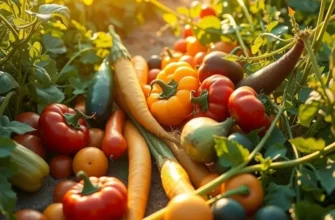Snacking can be a hurdle for those venturing into healthy eating. Balancing portion sizes while ensuring nutritional value is key to health-conscious habits. With a bit of creativity and planning, you can discover everyday snacks that are satisfying, nourishing, and easy to prepare. This guide offers portion-friendly ideas to fuel your journey towards healthier eating without sacrificing taste or enjoyment.
Nature’s Own: Fruits and Veggies

Fruits and vegetables are nature’s perfect snacks—vibrant, flavorful, and packed with essential nutrients. Incorporating them into your daily snacking routine can be a simple, budget-friendly way to boost nutrition. Here are some tips and tricks to help you enjoy these natural delights in the most effective and enjoyable ways.
One of the best things about fruits and vegetables is their portability. Many require no preparation; just wash and go. For manageable portions, consider investing in reusable snack bags or small storage containers. These can help you control portions, making it easier to resist overindulgence.
When it comes to preparation, simplicity is key. For vegetables like carrots, cucumbers, and bell peppers, a quick rinse and chop are all that’s needed. For added fun and flavor, pair them with a simple dip like hummus or a yogurt-based sauce. A handy tip is to prepare these snacks at the beginning of the week. Cut them into sticks or slices, pack into single-serving containers, and store in the fridge for convenient grab-and-go access.
For fruits, consider a mix of whole fruits like apples, bananas, and pears, alongside pre-prepped options. Some fruits, such as grapes and berries, can be washed and stored in aerated containers to maintain freshness. If you’re looking for variety and a bit of a treat, consider freezing grapes or berries for a refreshing, icy snack on warmer days.
When selecting fruits and vegetables for snacks, aim for seasonal produce. Not only is seasonal produce often more affordable, but it also tends to taste better and is more nutrient-rich. Local farmers’ markets can be a treasure trove for fresh produce at competitive prices. Additionally, some frozen fruits and vegetables are plentiful and budget-friendly when certain produce is out of season. They maintain most of their nutritional value due to flash freezing, providing a great option for year-round snacking.
Storage plays a crucial role in keeping fruits and vegetables fresh. For optimal storage practices that also reduce waste, consider checking the eco-smart kitchen storage tips. This approach ensures you not only enjoy your produce at its best but also contribute to sustainability efforts at home.
Incorporating these natural snacks into your diet need not be a chore. It’s about creating an environment in your kitchen where healthy snacking is easy and appealing. Once you establish a simple routine for preparation and storage, reaching for fruits and vegetables will become second nature, ensuring you always have delicious and nutritious options at your fingertips.
Quick and Tasty: Nut Mixes and Dips

Snacking can be both delicious and nutritious when you have a variety of nut mixes and dips at your disposal. Nuts are packed with healthy fats and proteins, making them an ideal snack choice. However, portion control is key to avoid overconsumption of calories.
Creating your own nut mix at home is both budget-friendly and customizable. Start with a selection of nuts like almonds, walnuts, and pecans. Add a handful of seeds such as sunflower or pumpkin seeds. For a hint of sweetness, toss in some dried fruit like cranberries or raisins.
Mixing spices can take your nut mix to another level. Try seasoning with a pinch of paprika, cumin, or even curry powder for a flavor boost. These spices can add depth without the need for excess salt. For more ideas on enhancing flavor without extra sodium, check out this guide on flavor boosters.
Remember, portion size matters. Aim for a quarter-cup serving size when munching on nut mixes. Using small bowls instead of larger ones can help you adhere to these portions.
If you prefer creamier snacks, homemade dips are an excellent choice. A simple Greek yogurt or chickpea-based dip can offer protein and fiber. For the Greek yogurt dip, mix one cup of yogurt with a tablespoon of lemon juice, a teaspoon of olive oil, and some chopped herbs like dill or parsley. This refreshing dip pairs well with carrot sticks or celery.
Chickpea-based dips are equally easy to make and equally nutritious. Blend a can of drained chickpeas with a tablespoon of tahini, a garlic clove, juice of a lemon, and a dash of cumin. Feel free to experiment with spices or add a spoonful of roasted red peppers for an added twist.
For those conscious about minimizing waste, consider using the liquids from canned chickpeas in other recipes, emphasizing sustainability in your kitchen. You can explore more on low-waste cooking here.
Serving dips involves mindfulness in portions too. Use smaller bowls or plates to help cue when a portion has been consumed, reinforcing your self-awareness and aiding in portion control.
With these simple tips and recipes, you can enjoy healthy snacks without breaking the bank. Nut mixes and dips provide a balance of nutrients and delight your taste buds, all while keeping your portion sizes in check.
Final words
Healthy snacking doesn’t have to be complicated or uninspiring. By incorporating fruits, vegetables, nut mixes, and flavorful dips into your routine, you can easily maintain portion control while enjoying a variety of tastes and textures. Remember, the key to a successful snacking lifestyle is planning and preparation. Make these options a staple in your home, and you will feel more energized and satisfied throughout the day. Think of snacking as an opportunity to nourish your body, rather than a guilty pleasure.







